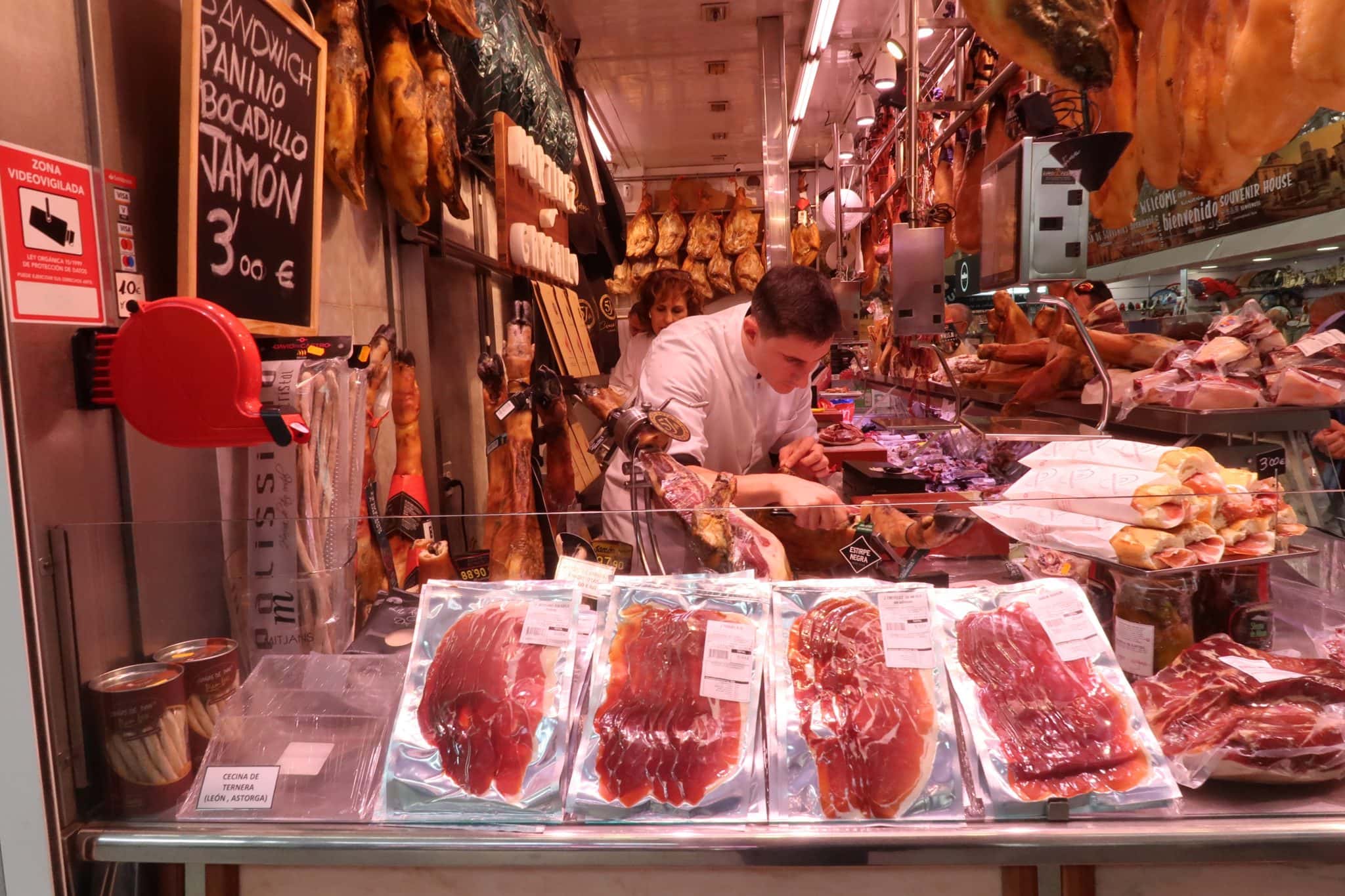This site uses affiliate links, meaning that if you make a purchase through our links, we may earn an affiliate commission.

Spanish Ham - Jamon Iberico
Why Is It so Good?
Spanish Ham Is the Essence of Spain
On the first bite, the flavor of the Spanish ham is incredible: sweet, nutty, and not too salty. Then the complexity of the flavors increases as the rich, creamy fat melts away in your mouth.
It releases the essence that tells the story of the Iberian pig, of the Dehesa—the rangeland—of years of careful curing, and of Spain itself.

Jamón, or in English – ham, is part of Spain.
It is a fundamental part of the Spanish culture and a quintessential part of Spanish food.
Its presence is imposing! It is everywhere!
From the coastal areas to the mountainous regions of Spain, you will always spot jamones – hams hanging from the rafters or being placed in a jamonera – ham holder, or being freshly sliced with a cuchillo jamonero—a long and flexible bladed knife.

Spanish Ham – Jamón 100% Ibérico de Bellota
Jamón 100% Ibérico de Bellota (bellota – acorn) is the pride of Spain.
It translates to ham made from free-range 100% pure bred Iberian pigs that eat acorns.

Don’t have time to read it now?
Save it on your Pinterest board!


The Iberian Pig
The origin of the Iberian pig goes back thousands of years. They are the descendants of the wild boars that still roam the Iberian Peninsula and are featured in Pre-Neolithic cave paintings located throughout the Iberian Peninsula.
The Iberian pigs are brown-black, with very little hair. Their snouts are long and conveniently designed to forage. They grow big and fat – the deep layer of fat not only covers their bodies but the veins of fat run deep through their muscles.
It is the high fat that allows the Ibérico hams to be cured much longer.

Their legs are long and slender though – like athletes’ legs – with the famous pata negra – black hooves, which remain on the Ibérico ham throughout the curing process.
It is one of the things that distinguishes the Ibérico ham from a second runner up – Serrano ham.
The Iberian pigs roam an average of 14 kilometers a day up and down the oak covered hills of the Dehesa – the ancient rangeland of southern and central Spain.

Dehesas may be private or a communal property. They are used for grazing and produce variety of items: wild game, mushrooms, honey, and cork; it is the home of the Retinta cows and Merino sheep; it is the natural habitat for the Spanish fighting bull and the home of nearly extinct Spanish imperial eagle.
The tree component of dehesas is oak: holm and cork – each tree takes between 30-40 years to grow to maturity and can live for hundreds of years while producing a multitude of bellotas in the fall.

Why Spanish Ham – Jamon Iberico Is so Good?
The Iberian pigs feast on rich, sweet bellotas – that period is called montanera.
They gain as much as a kilo of weight a day. The acorns eaten are rich sources of oleic acid, the same chemical found in olives.
The oleic acid is stored in the fat of the ham and much of the fat is mono-unsaturated fatty acid that facilitates the production of HDL (good) cholesterol.
They are sometimes called ‘walking olive trees’ or ‘olives with legs’ because their fat is nearly as healthy as extra virgin olive oil.

The Curing Process of Spanish Ham
The preserving of pork leg as ham has a long history.
Many credit the Chinese as being the first people to record curing raw hams. It cannot be argued though that it was a well-established practice by the Roman period. Cato the Elder, a Roman Senator, wrote extensively about the ‘salting of hams’ in his De Agri Cultura tome around 160 BC.
We know that when Christopher Columbus set out to discover the New World with three ships from Palos de la Frontera in Spain on 3 August, 1492, he had jamones aboard.

The curing process is uncomplicated and yet complex. Simple, because all you need is: salt, air and time. Complex, because the devil is in the details: the salting, heating, cooling, drying process must be meticulous and the time frame varies from ham to ham.
First, the freshly cut hams are covered with sea salt for a few days, a week or weeks. The amount of salt and the length of time are determined by the depth of the layer of fat which covers each ham and must be measured with precision.
Second, the hams are rinsed in lukewarm water.
Next, follows the resting period, in areas with cold temperatures, yet relatively high humidity so that the remaining salt can still penetrate the hams. The time varies and is relative to each ham.
Finally, the bodega phase – drying and maturation – can last 2 years or more.
As the seasons pass and winter moves to spring and spring into summer, the hams ‘sweat’ and the meat becomes drier; and then the hams cool off again as the second winter starts.
By the time the ham master, who supervises the curing process, declares which ham is ready for consumption, they lose nearly half of their weight as they sweat and the fat melts away. The result is a very thin leg of ham.
The ham master checks on the hams by inserting a thin sliver of a bone into the interior of the curing ham; the sight, smell and taste will determine his decision. It is like inserting a wooden stick into a cake to help you decide if it’s ready or not.

Final Thoughts About Spanish Ham – Jamon Iberico
The ham that I had was sliced paper thin and placed on a plate warmed up to the room temperature.
The meat had deep dark red color and was well marbled. The warmth of the plate melted the fat, giving the slices a shine and releasing even more flavor and aroma.
As I placed the first sliver of the jamon in my mouth, I took into account that not all foods are created equal. It was delicious and it simply melted in my mouth.

By the way, I would like to hear back from you! Have you ever tried Spanish ham? If yes, which variety did you try?
Leave me a quick comment right below!
Did you find this useful?
Why not pin it on your Pinterest board!








Comments:
4 thoughts on “Spanish Ham – Jamon Iberico – Why Is It So Good?”
Hi there,
I love your blog of Spanish jamoń, yum. You have some really good info, you did a great job. If you are ever in Barcelona, I would love to show you some amazing places to eat in the city. I run a food tour company called Eye on Food Tours drop me a line some time.
all the best,
-A
Thank you! I will check out your website.
Who knows, I might be in Barcelona one day!
Are you from Spain?
Hi,
Yes we are and under lockdown day 26 ? the city is so quiet these days. looks like we are going to under lockdown till April 26th, fingers cross. stay safe
-A
Hi,
Yes, we are and under lockdown day 26 ? the city is so quiet these days. looks like we are going to under lockdown till April 26th, fingers crossed.
We hope to see you soon in Barcelona, all the best.
stay safe
-A